SharkRF OpenSpot 4 Pro Review

SharkRF Openspot 4 Pro
I bought a SharkRF Openspot 1 in around 2018. So I have been a long time user of SharkRF gear. I absolutely, positively did NOT need another DMR hotspot but I sprung for the SharkRF Openspot 4 Pro anyway.
Boy I sure am I glad that I did.
I am no hotspot rookie and currently have 4 Raspberry Pi with various MMDVM boards in rotation here at Casa John’s Tech Blog. I run Pi-Star and WPSD OS’s. And have toyed with various other OS’s over the years.
There are strengths and weaknesses in all these DMR hotspots. One weakness in the Pi-Star world is that it needs to be shut down elegantly. When you have a hotspot plugged in a USB port in your truck which uses your cell phone for internet it is kind of hard (and very inconvenient) to find the IP address, open a web page on your phone and shut it down. Sooner rather than later you are going to corrupt the SD card on the Raspberry Pi if you just kill the power. In fact I have done this a few times.
The SharkRF Openspot 4 Pro caught my eye because it is battery powered.
And that is all I really wanted for my mobile hotspot. Something I wouldn’t kill from uncommanded shut downs.
What I got was so much more than I expected. Read on.
My DMR Needs
I use Brandmeister, TGIF, and C4FM (Yaesu System Fusion). I don’t do much cross mode stuff. WPSD will do Brandmeister and TGIF at the same time but chaos ensues when you add C4FM to the mix without disabling the other stuff.
Pi-Star does do Brandmeister and TGIF simultaneously but let’s just say “it ain’t elegant”.
Also when you add TGIF to these OS’s you have to change the Talk Group ID numbers. For example, WPSD needs a leading 5 with a 7 digit number. Talk group ID 114 becomes 5000114. That in itself isn’t so bad or hard to program but it MARRIES THAT RADIO TO THAT HOTSPOT. That might be okay if you only talk on one system and only own one hotspot. But that is definitely not my situation.
OpenSpot 4 Pro
I don’t even know where to start. It only took a few minutes to connect to Brandmeister. Add the API Key (not depicted) , your server password, and select a BM server (3102, or 3103 are my favorites) and it just starts working.
Connectors
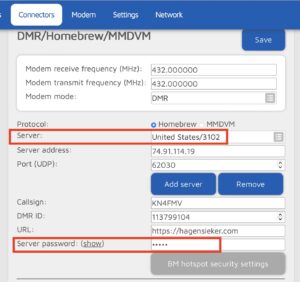
Connectors Page
Profiles
Everything you do is saved to Profile #1. I then named that profile “Brandmeister”. Then you copy Profile #1 to Profile #2 and then switch to that profile. (In the example screenshot below I am copying Profile #3 to #6 which I will later name C4FM Cellular.
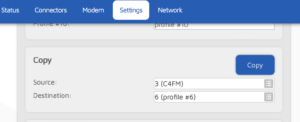
Copy Profile
Set profile #2 up to TGIF and save it. Now you can switch from Brandmeister to TGIF in a couple of seconds elegantly. The profile selection box is at the lower left side of the page.
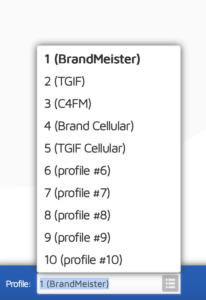
Switch Profiles
You’ll notice that Profile 1 is Brandmeister and Profile 4 is Brandmeister Cellular. When switched to a profile you can select what WiFi network you connect to. In this case I swapped my home Wifi to the #2 spot and my cell phone being the primary.
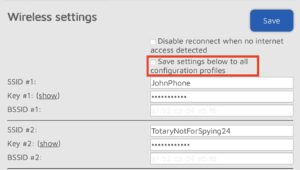
Network Setup
PRO TIP: Make sure the box that says “Save settings below to all configuration profiles” is unchecked. Otherwise whatever you select will go back and swap the order of all your other profiles.
Anyway, if I am headed for the car I just switch the profile and it hooks up to my cellular hotspot. Don’t forget that also changes the IP of your device as well.
Switching profiles can be done with your radio. Programming in Talk Group ID 9001 equals Profile #1, 9002 equals Profile #2, etc. This is AWESOME.
[kad_youtube url=”https://youtu.be/yKy9jiycvsk” ]
Special Features Of The SharkRF OpenSpot 4 Pro
SharkRF Link
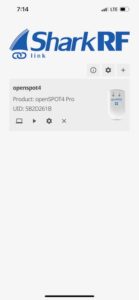
SharkRF Link
With the OpenSpot 4 Pro you can use your cell phone as the communications devices. This precludes the need for having a radio and HAVING TO PROGRAM A RADIO.
This is an amazing feature.
And if programming a radio intimidates you early on you can just select your Talk Group number from within the app to easily change to that channel/room or whatever you want to call it.
Just hit the start arrow within the box. I have mine set to the TGIF talkgroup. When I key up it looks like this:
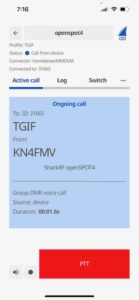
SharkRF Link Transmitting
One more cool thing to mention here: THE AUDIO QUALITY ON THE SHARKRF LINK IS SUPERIOR TO ANY RADIO I HAVE IN THIS HOUSE.
At least i think so.
Hardware Transcoding
The SharkRF OpenSpot 4 Pro (only) has hardware transcoding. The 4 has software transcoding. This is supposed to give improvements in audio quality especially when using Cross-Mode communications.
Final Thoughts
You can do most digital modes on most hotspots however the ability to create separate profiles which are already saved and switch between them is a Power User feature. And it is a feature that I think puts it head and shoulders above WPSD or Pi-Star. I’ll still use those OS’s at home but the Open Spot being battery powered makes it super mobile. As I discussed earlier if you shut down a Raspberry Pi hotspot by just chopping the power it isn’t a matter of IF you will corrupt the SD card but rather WHEN.
And using your phone as a transceiver is yet another Power User feature.
I can highly recommend the SharkRF OpenSpot 4 Pro. If there is any con at all it is the price.

WPSD has profiles. Unlimited.
It’s the icon directly up top in the navbar
Ì M visually impaired and Do not have the balance to put up an internet. I can not work HF. Can̈ Speak to Someone about a special offer or somè Short of payment plan. Wish to use the 4 pro on A Samsung android phone. Mÿ Email address is . or